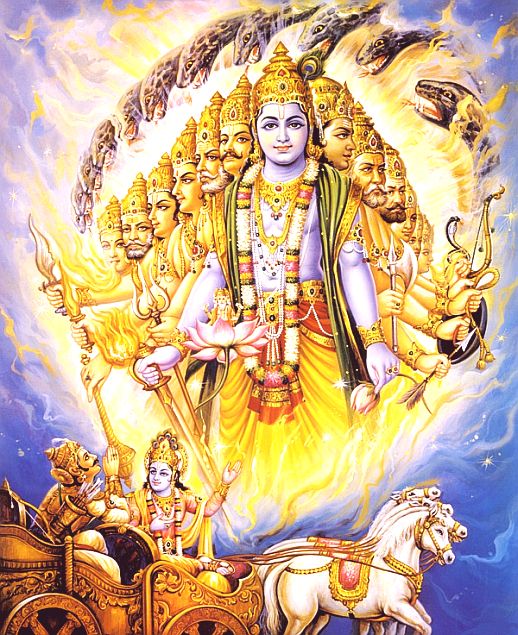The Bhagavad Gita (श्रीमद्भगवद्गीता), means the Song of God is found as a 700 verses (solkas) text in the Bhishma Parva of the epic poem Mahabharata.
Many historians claim that Gita was not part of original Mahabharata and was later added around 1800 BCE during Gupta Maurya dynasty rule.

The fact remains that Mahabharata as found today with 100,000 verses was completed several centuries later by addition of many stories told by sages to their disciples.
Original version was named ‘Jaya‘ which had 8800 verses only and was narrated by Veda Vyasa to Ganesha (Read this article for more clarity on Mahabharata’s original version).
Bhagavad Gita Facts, Dates and Authors
There is also one more blind assumption that time was frozen by Krishna when he narrated 700 slokas to Arjuna.
This is based on fact that it takes atleast 2-3 hours to narrate 700 slokas and warriors on either side would not have patiently waited for Krishna and Arjuna to finish their conversation before war began on day 1 in Kurukshetra.
sri-bhagavan uvaca
imam vivasvate yogam
proktavan aham avyayam
vivasvan manave praha
manur iksvakave ‘bravit – Bhagavad Gita 4.1
Translation : Supreme Lord said: I instructed this imperishable science of yoga to the sun-god, Vivasvan, and Vivasvan instructed it to Manu, the father of mankind, and Manu in turn instructed it to Iksvaku.
Iksvaku is the founder of Iksvaku dynasty and ancestor of Lord Rama.
In Mahabharata (Santi-parva 348.51-52) one can find the history and origin date of the Gita:
treta-yugadau ca tato vivasvan manave dadau
manus ca loka-bhrty-artham sutayeksvakave dadau
iksvakuna ca kathito vyapya lokan avasthitah
Translation : In the beginning of the Treta-yuga [epoch] this science of the relationship with the Supreme was delivered by Vivasvan to Manu.
Present Kali Yuga is 5100+ years old and before that Dwapara Yuga lasted for 864,000 years.
Prior to that Treta Yuga lasted for 1,296,000 years (refer : Age of Brahma, the Creator.
So, the original and first version of Gita was narrated by the supreme lord more than 2 million years ago to mankind.
Before war, when Arjuna was down with depressing thoughts of killing his own relatives and gurus, Krishna must have given him a motivational speech for few minutes and made him realize the Viswaroopam(Infinitude), so that Arjuna gets detached from all thoughts of bondings and follows the Kshatriya Dharma (Duty of King) of war to restore peace and Dharma on earth.
So, Krishna did not do any trick or magic and time did not freeze.
Authors who later expanded ‘Jaya‘ from 8800 slokas to 24,000 slokas (Vijaya or Bharata) and then to 100,000 slokas (Mahabharata) must have embedded the original verse of what was said in Treta Yuga.
However, it was also not re-written in a consistent form.
The original Gita is said to have 740 slokas and Mahabharata does not divide them into 18 yogas or chapters.
We can find in present day Gita that it was written by multiple persons as few intial slokas appear in first person narrative and suddenly it jumps into third person narrtive.
Gajanan Shripat Khair, who researched for 43 years on Bhagavad Gita, concluded in his book ‘Quest for the original Gita‘ that infact it was written by 3 persons over 400 years and that is why narrative lacks continuity.
Also few inclusions like ‘description/creation of caste system’ , ‘women, sinners and lower castes’ being treated similarly etc were according to the society in those years.
Bhagavad Gita became popular after Adi Sankaracharya wrote commentaries on them.
Author (here, Krishna) himself claims that the original science was not carried forward as it is by successive kings.
evam parampara-praptam
imam rajarsayo viduh
sa kaleneha mahata
yogo nastah parantapa – Bhagavad Gita 4.2
Translation : This supreme science was thus received through the chain of disciplic succession, and the saintly kings understood it in that way. But in course of time the succession was broken, and therefore the science as it is appears to be lost.
After war and restoring peace, Arjun remembers that Krishna told him something in brief before commencing war but could not recollect it.
He asks Krishna to repeat it and the other version narrated later is known as ‘Anu Gita‘ and is part of Aswamedhika Parva of Mahabharata.
The main topics discussed in Anugita are transmigration of souls, means of attaining liberation, description of gunas and ashramas, dharma, and the effects of tapas or austerity.
References :
